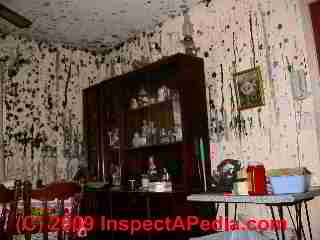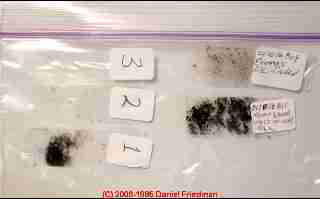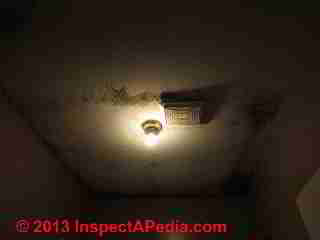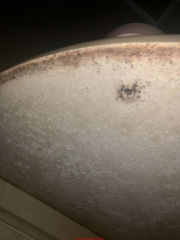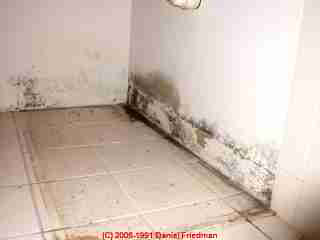 Mold on Walls, Drywall, or "Sheetrock®"
Mold on Walls, Drywall, or "Sheetrock®"
Causes of mold growth indoors
How to Find & Test for Mold on Walls
- POST a QUESTION or COMMENT about mold growth on building drywall surfaces and about mold testing procedures
Guide to testing mold on building drywall:
This article describes proper procedures for sampling mold on drywall in buildings. Because moldy drywall or "sheetrock" is often the consequence of a building flood or wet floor, the moisture gradient in drywall varies at different heights above the floor surface. Because different mold genera/species vary in their hydrophilic nature (some molds love water more than others), different mold genera/species are likely to be found at different heights on a building wall. Which molds are most important to sample?
This article series describes how to find mold and test for mold in buildings, including how and where to collect mold samples using adhesive tape - an easy, inexpensive, low-tech but very effective mold testing method. This procedure helps identify the presence of or locate the probable sources of mold reservoirs in buildings, and helps decide which of these need more invasive, exhaustive inspection and testing.
InspectAPedia tolerates no conflicts of interest. We have no relationship with advertisers, products, or services discussed at this website.
How to Test or Sample Building Drywall, Gypsum Board, "Sheetrock" and other Building Surfaces for Mold Using Clear Adhesive Tape
- Why & where mold grows on drywall: how much moisture, water, or leakage is necessary for mold to grow on drywall - mold growth below leaky skylights & windows
- Moldy drywall sampling mistakes to avoid; proper use of a flashlight finds "hidden" mold on drywall
- What mold looks like in different areas or on different surfaces of drywall
- Why are different mold genera/species found at different heights on building walls? We illustrate how three tape at three nearby locations on drywall can collect three completely different mold genera/species
- How should mold test samples be collected from building surfaces?
As I've explained in various articles and at DUST / MOLD TEST KIT INSTRUCTIONS, different mold genera/species will be found growing on the same or nearby sections of drywall on a building surface, depending on several variables.
If the largest contiguous mold area in a building is trivial in amount, say 1 sq .ft., we would not test it unless we thought that the mold we see is representative of a larger mold problem I cannot see. Small areas of mold should simply be removed.
For larger areas of mold (certainly if more than 30 sq .ft. of area is moldy or if mold is growing on many surfaces in a building), you are looking for the dominant species present and particularly allergenic or toxic species present in the environment.
The photo at page top shows several colors of mold on a drywall surface. Still more mold may be present but still lighter in color and harder to see. Each of these may be a different mold genera or species. Which molds that we see on a building surface should be sampled? We explain the answers here.
This article is part of our 'how to' photo and text primer on finding and testing for mold in buildings using simple clear adhesive tape on suspect or visibly moldy surfaces.
Also see MOLD GROWTH on SURFACES, PHOTOS
How to Decide Where to Sample for Mold and How Many Mold Samples To Collect
Collect one mold tape sample per location; do not use the same tape to sample from multiple locations.
- Choose a representative sample spot: select a representative spot of mold growth on a surface such as a wall, cabinet, ceiling or floor.
This means that if you see what appears to be a single coating of mold-suspect growth on a surface, all rather consistent by color, texture, and what it's growing-on, you need only one sample of that material. Variations in appearance or texture or growth surface or mold growing in different building areas or floors are reasons to sample more than one thing.
In our photo (above left) of severe indoor mold contamination in a home, many different mold genera/species were present on the drywall (sample by color or texture) as well as still other genera/species that varied by growth surface, type of wood, painted surfaces, other materials. - Color: Sample molds of different colors: black, white, green, red, gray, brown, yellow, pink - are often (not always) different species.
- Texture: Sample molds of different textures: hard lumpy big grainy versus fuzzy and easily blowing into the air - are often (not always) different species.
- Growth Surface: Sample molds growing on different building materials. This is quite important. Completely different mold genera and species
may be found growing in the same building on different growth substrates: drywall room side, drywall cavity side, plywood sheathing,
wood stud or joist framing, painted surfaces, exposed fiberglass insulation kraft paper vapor barrier - are often (not always) different species.
Even on the same growth surface (drywall for example) different mold species appear at different locations according to variations in moisture level - explained just below) - Building area: basement, crawl space, living area, and attic all have different moisture conditions, often different building materials, different patterns of air movement and exposure. The "green mold" found on wood subflooring visible overhead from inspection in the basement is very often a completely different genera and species from the "green mold" found on the roof sheathing in the attic of the same building.
- Representative dust samples: we will sometimes screen areas where there is no visible mold by collecting settled dust particles
from a horizontal surface.
If you are going to collect a single dust screening sample, collect it either from the area of which you are most suspicious (a flooding basement), or from the area where building occupants spend the most time (perhaps a bedroom or family room). - Variations in moisture gradient in the drywall - so if a floor was flooded, water-loving molds
grow closest to the floor (such as highly-visible black molds like Stachybotrys chartarum),
while molds liking the drywall to be a little less wet grow a little higher (such as Cladosporium sp., Cladosporium sphaerospermum, Cladosporium cladosporioides, Ulocladium chartarum), and molds liking the drywall to be still less wet grow higher still on a vertical wall (such as Aspergillus sp., Aspergillus glaucus, Aspergillus flavus, Penicillium sp., etc.).
Therefore where the tape sample is collected can make a big difference in what you find.
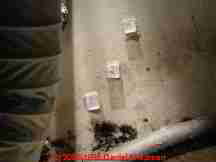
In the first photo of moldy drywall, three completely different mold genera and species were within a few inches of one another
at different heights on this laundry room wall.
This condition often occurs, but the different genera may be as close as inter-mixed and even overlapping in the same area, to growing several feet apart on the same wall, to growing in the same building but on different materials on different surfaces.
In this case, tape sample #1, the bottom mold, was Stachybotrys chartarum, tape sample #2, the middle mold, was Cladosporium sphaerospermum, and the top tape sample, #3, was Aspergillus flavus. Of these three, the Aspergillus is the easily-airborne toxic spore which is more likely to be a problem in the building if it is present in sufficient quantity.
At MOLD LEVEL REPORTING we explain the errors you can expect if you do not choose a properly-representative area of a surface when collecting mold or dust samples and
at MOISTURE GRADIENTS & MOLD we explain why we find different mold genera/species at different locations on moldy drywall.
How to Prepare & Save Mold Tape Samples for Mailing to a Mold Test Laboratory
In this photo detail you'll see that using a new and clean zip-lok™ bag, we placed several surface tape samples on the same bag. If you can't assure that the bag surface is clean between tape sampling, use a new bag for each sample.
- Interruptions in the moisture gradient absorption path: for example at a wet floor which soaks the bottom
of drywall, moisture wicks up into the drywall material.
But moisture wicking may be reduced suddenly at a horizontal drywall joint, resulting in easily-visible borders or lines in fungal growth. - Exact pathway of water on a surface or in a building cavity: so tracing the exact water path through a ceiling or wall cavity is very important.
Are you collecting too many mold test samples?
There are nearly always multiple mold species present in any environment where mold producing conditions are present.
We sample surfaces likely to host different molds, focusing on surfaces which appear to represent mold or mold-suspect material growing over large areas in the building. Don't collect and send 50 samples. If you find you want to collect a great many samples it would probably be smarter and more economical to bring in an expert to survey the building and who can sample more strategically.
Interrupted Mold Growth Pattern on Building Drywall - Why Does Mold Growth Sometimes Stop in Straight Lines?
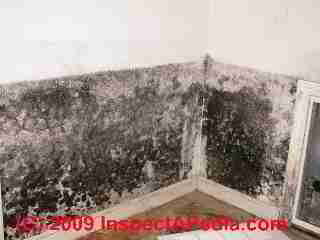
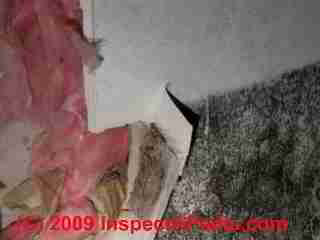
In our photographs shown above the thick black mold growth on drywall in a wet basement appears to nearly "stop" in a neat horizontal line just about four feet from the floor surface. Why?
Stachybotrys chartarum, which dominated the mold on this drywall, really likes wet conditions. As we explained above, the genera/species of mold growth may vary on a surface of the same material as a function of variation in moisture levels in the material.
In our photo at above right we show by having made a test cut into the moldy drywall that mold growth stopped its rapid advance up the drywall when it encountered the horizontal tape joint between the lower and upper runs of drywall in the building. We have found two common explanations for this observation:
- The moisture wicking upwards in drywall from a wet floor is interrupted where the paper-covered edges of two horizontal runs of drywall abut.
- Mold growth on joint compound alone is often significantly less in a building than on paper-covered drywall in the same area. This observation describes the success in "paperless drywall" sold for some applications.
How to Relate Mold Growth Pattern to Building Leaks or Moisture Vairations
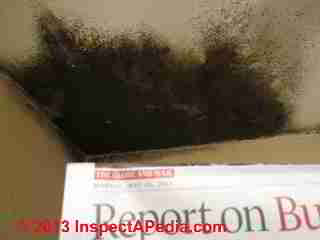 Reader Question: why is this black mold growing on these drywall ceilings & walls?
Reader Question: why is this black mold growing on these drywall ceilings & walls?
I attached three mould photos for you. Can you help me to find out the possible reasons? - L.Y. 6/4/2013
Reply: Summary of common reasons for mold growth on drywall
A competent onsite inspection by an expert usually finds additional clues that help accurately diagnose a problem. That said, here are some things to consider:
Possible reasons for indoor mold growth ?
In all cases of indoor mold growth the mold needs food (wood, paper, organic material), oxygen, and water; some molds thrive on light, some are tolerant or intolerant of UV, and other factors.
Moisture, water, leaks, condensationa are key determinants in indoor mold growth
Of all of these, water is the key necessary ingredient which we can track and which is inviolate - that is, no water, no moisture = no problem mold growth.
I have no context for the photos, no age, no building history, occupancy, use, or other key information that an onsite inspection would disclose.
But I note that your middle photo looks as if it is a ceiling and because there is a vent therein I suspect this may be over a bathroom; Common moisture sources for such an area might include
- leaks into the ceiling above
- high indoor moisture from in-building sources such as a steamy shower or clothes dryer
- leaks from the ducting for the ceiling fan
The density of mold growth in your photos suggests that there have been leaks from above. But in some cases even without actual water leaks into a ceiling or wall we can see dense mold growth on building drywall caused by other wet building conditions (flooding of the floor for example, or a heating or steam pipe leak).
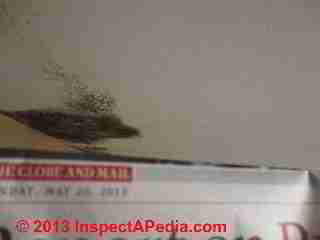
Mold growth tracking ceiling or wall framing
The fact that the mold seems to track or be more dense along lines resembling either drywall joints or actual locations of framing would argue for either leaks from above penetrating at drywall butt joint seams or quite often, temperature differences (wood framing in contact with drywall produces cooler temperature than insulated ceiling cavities).
Temperature variations can in turn invite higher levels of condensation on cooler surfaces in those areas. We also see this effect
in THERMAL TRACKING & THERMAL BRIDGING
So even when we don't see leak stains showing a water source, the mold growth pattern might track moisture gradient in the materials and thus suggest something about its cause.
You will need to remove the moldy drywall in any case, as well as any insulation that has been wet or exposed to mold.
That will let you inspect the wall or ceiling cavity for leaks as well as to check that the bath vent fan is actually venting and is properly used.
Reader Follow-Up:
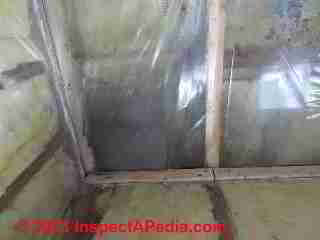 But how to explain the reasons for this photo? It is the most black area (I showed in previous email)when my landlord removed the ceilling, there has plastic.
But how to explain the reasons for this photo? It is the most black area (I showed in previous email)when my landlord removed the ceilling, there has plastic.
`Actually I know very little knowledge about mould. My landlord said the mould was caused by the lack of heat. Can you show me some ideas?
Does the water stain of the second picture show water leakage? This house is more than 40 years old.
There is no indoor ventitaltion system, the fan in the bathroom has been blocked for long time and the fan had not been insulated well.
There's no fan to transfer gas to outside in the kitchen. - Y. 6/5/2013
Reply:
Mold is is not directly caused by lack of heat - cooler temperatures in fact retard mold growth, if all other conditions are equal. But lack of heat that leads to condensation problems or to a frozen burst pipe and leak can indeed cause or encourage indoor mold growth.
And I would agree that heating a building, as it dries a building, would avoid problem mold growth provided that there are not leaks or abnormal moisture sources.
If there is mold there is a condensation or leak problem to find and fix. If the mold is on the wall cavity side of the plastic then there are leaks into the wall cavity - either water leaks or air leaks, perhaps combined with incomplete or improper insulation. I'd have to see more detail to have a more confident opinion. From your photo I'm not even sure what's ceiling and what's wall.
Some speculative examples of what could be going on include:
- water leaks in to the plastic-covered cavity
- moist air leaks into the plastic-covered cavity from either side of the wall, ceiling or whatever we're looking at
The suggestions I made earlier about tracking down leak and moisture sources should, perhaps in this case, be combined with inspection for air leaks into the cavity from indoors or from outside.
At What Moisture Level Shoudl Drywall Simply be Removed?
Reader question: 1/30/2014 Phil said:
What % of moisture or water penetration into Drywall can it reach before it can not be dried and has to be removed. Also, if there is a time limit on when you have to start the drying process.Reply:
Phil, that's an interesting question and I haven't thought about wet drywall quite that way. Let's try this:
If drywall is wet above 18% or so, even if just measured on the drywall surface, then conditions are ripe for mold formation; Generally the rate at which mold will grow on wet drywall depends on moisture levels and temperature; While there are molds that will grow under just about any condition, in buildings drywall mold of any of about 40 common genera/species will show up in 24-48 hours.
Wetter drywall grows different species (such as Stachybotrys chartarum) than less-wet but still too-wet drywall (18% say) (such as Aspergillus sp.).
So I would say that regardless of how wet the drywall is to start with, if we could get it dry - say at 10-2% or less throughout its thickness - in 24-48 hours and if we don't already see mold growth on it, we're probably OK.
Watch out: however if drywall is really soaked we have to ask where the water came from, where it flowed in the building, and what else got wet.
For example, if drywall is soaked because of water flowing through a ceiling or wall cavity, if we do not open that cavity, remove insulation, and get the entire cavity and all materials dry quickly enough, we're likely to have a costly mold contamination problem there. In such cases, deciding to keep or leave drywall in place because of its surface or room-side moisture could be a mistake.
Reader Comments, Questions & Answers About The Article Above
Below you will find questions and answers previously posted on this page at its page bottom reader comment box.
Reader Q&A - also see RECOMMENDED ARTICLES & FAQs
On 2020-03-02 by Elizabeth - possible mold + painted-on-design bleed-through + shower seat damage
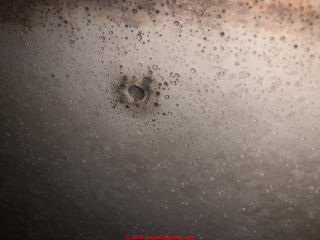 No other areas that have these spots. Only in master bathroom. Thanks again
No other areas that have these spots. Only in master bathroom. Thanks again
Thank you. I will have it checked immediately!! This has helped me greatly. I appreciate your input greatly
On 2020-03-01 - by (mod) - The walls are interior Sheet rock in my bathroom - mold risk
I did not mean to suggest that could not be mold.
In other building areas out of the bathroom if you're seeing sooty dust deposits that's a concern that made me want you to focus first on the immediate life safety hazard of an unsafe gas heating Appliance.
If there is painted drywall in the shower and it's been wet and if you see mold-like growth, then it's very likely that there's mold on the drywall and possibly on the cavity side of the drywall as well.
You don't say how the shower seat is constructed nor what are its materials so we can't assess the mold risk except to say those dark stains might be mold but the bubbles or round openings are some other product or paint coating defect.
In that case painting over it will not cure the problem and it needs to be cut out and removed.
It's not a good practice to try to have drywall as a wall covering in a shower. You need a waterproof material.
On 2020-03-01 by Elizabeth
The walls are interior Sheet rock in my bathroom. The last picture is inside my open top shower stall. The black tiny spots are the bottom of the shower seat inside my shower. There’s a lot of humidity when we shower even with vent on
. I am bewildered by how weird all these spots are. Creeps me out. I pray it’s dust sticking to something under the paint and not spores.
This is a brick on slab home built in 1995. We have two gas furnaces . So you don’t believe these are mold spores ? Just to confirm your opinion. I will keep you posted on the outcome of the inspection. Thank you again.
On 2020-03-01 - by (mod) - painted-on leaf design is not, itself, mold
tiny bubble defects looks like a paint or coating failure; the larger black crater could be a moisture indicator: is this an exterior wall or does it contain plumbing? What are the wall materials?
On 2020-03-01 by Elizabeth
This is inside the shower under shower seat. It keeps coming back also
On 2020-03-01 by Elizabeth
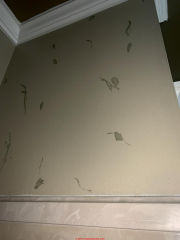 Elizabeth said:
Elizabeth said:
That’s what the owner said, his wife had leaves painted onto walls . So there’s not any fungus or mold pattern that resembles this? The edges Are not even and don’t look like leaves. Our walls sweat terribly in this bathroom. And in addition there’s black mold looking stuff that is constantly appearing inside of shower under shower seat. I really appreciate your input. My concerns are great.
My 18 year old was recently diagnosed with an autoimmune disorder caused by Epstein Barr virus, fibromyalgia and chronic fatigue . Somewhere on this site it speaks about mold or fungus causing these exact issues.
Yes we actually have a carbon monoxide detector that’s monitored by our alarm company. I will call an inspector tomorrow. This company also inspects for mold. I will post the image of shower seat in next thread.
This image is wall inside our shower. Thank you again.I’m not sure my other post went through but this is another image from the wall inside of the shower the edges are not even and I don’t think they look like leaves .
The owner said his wife had them painted . it’s a lot of leaves ! is there a fungus or mold that looks like this?
my 18-year-old was recently diagnosed with fibromyalgia dysautonomia chronic fatigue all caused by the Epstein bar virus. somewhere on this site it said that those are some issues that could be caused by mold or fungus. And yes we do have carbon monoxide detectors there a smart bar alarm company .
Thank you for I’m not sure my other post went through but this is another image from the wall inside of the shower the edges are not even and I don’t think they look like leaves .
The owner said his wife had them painted . it’s a lot of leaves ! is there a fungus or mold that looks like this? my 18-year-old was recently diagnosed with fibromyalgia dysautonomia chronic fatigue all caused by the Epstein bar virus.
somewhere on this site it said that those are some issues that could be caused by mold or fungus. And yes we do have carbon monoxide detectors there a smart bar alarm company . Thank you for
On 2020-03-01 - by (mod) - painted on wall design bleeds through paint-overs
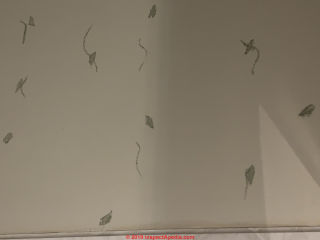 The fact that this is a painted-on design that keeps recurring suggests to me that this is not likely to have a thing to do with a mold problem but rather you need to seal the wall surfaces with a suitable primer-sealer such as Bin or Enamelac before re-painting.
The fact that this is a painted-on design that keeps recurring suggests to me that this is not likely to have a thing to do with a mold problem but rather you need to seal the wall surfaces with a suitable primer-sealer such as Bin or Enamelac before re-painting.
"Black dust" settling over building surfaces is more-likely to be soot from an improperly-operating (AND UNSAFE) gas heating appliance.
Be sure you have working carbon monoxide detectors properly located and installed and have the heating system and its combustion air supply, venting, and burner operation checked right away.
On 2020-03-01 by Elizabeth
We are very concerned about these spots. We are in process of buying this home and currently renting it.
We are planning on getting inspection done for mold etc ASAP.
Owner stated his wife had painted leaves previously.
We clean them and it comes back. There’s also a black dust that settles in the bathtub and all surfaces in bathroom. We have a gas furnace. Is this mold spores? Please advise . Thank you
On 2019-09-08 - by (mod) -
Gee, I dunno, Roxanne; if the material is hard and dry the question is - is this new or was it always there but not previously noticed? Perhaps you can use the Add Image button to post a photo.
On 2019-09-08 by Roxanne
We have something that looks like dried glue coming out of the bottom of our drywall in our garage and there is alot of it what is it?
On 2019-09-08 by (mod) - what is the hard glue stuff on our drywall?
Gee, I dunno, Roxanne; if the material is hard and dry the question is - is this new or was it always there but not previously noticed? Perhaps you can use the Add Image button to post a photo.
We could be looking at construction adhesive - or - of course - something else
On 2019-09-08 by Roxanne
We have something that looks like dried glue coming out of the bottom of our drywall in our garage and there is alot of it what is it?
On 2017-11-07 by (mod) - mold on pillow cases and other bed linens
Lisa
I have seen mold on pillow cases and other bed linens in homes that have been seriously soaked by Plumbing Leak or roof leak or burst heating system pipe while unattended. It's not something I would expect to see in an occupied home. My suggestion is to inspect the property and look for leaks into any building cavity such as ceiling or wall, or wet basement or crawlspace.
On 2017-11-06 by Lisa
I have a tenant who is states he is finding mold on some pillow cases, a bureau and pillows . This summer has been very humid. Any ideas?
On 2016-06-21 by Rosemary Spinelli water leak issues
I rent have been in house 6 months had 3 water leak issues. This last one in the living room we had to remove the patch in dry wall that the water was coming in from,
once we cut it open the whole wall behind was all black mold the wood used to frame the house was so moldy and rotten you could push your finger threw it.
I want to know where I can send samples to be checked. The landlord dose not think it is a big issue. We have found and fixed the roof leak
On 2016-03-29 by (mod) -
Freon leaks don't cause mold, but condensate leaks wetting a wall cavity can be a problem; just treating the surface is not an effective repair. A wall cavity that was wet before can have an ongoing hidden mold problem even though the water source itself is no longer present. Open and inspect and remove and clean as needed.
On 2016-03-29 by Anonymous
I have mold growing on the surface of my drywall I have repaired at once and found a leak in the freon lines and condensate line they're running behind the wall. There is mold on the painted surface this time but no mold on the back of the drywall and no moisture that I can find now of course the AC is not running.
It is a downstairs bedroom the only one on that floor adjacent to the garage it's ground-level floor on a concrete slab any suggestions would be helpful
On 2015-07-09 by Johnny
I'm in the process of renovating my basement. The basement area was a two car garage in a split level home in which the previous owner converted one bay into living area. I'm tearing up the carpeting and replacing baseboard. On some walls in the finished area I found what appears to be black mold.
The previous owner did mention having had a flood at one point (few inches of water) and had a french drain installed to help mitigate water problems. This was years ago. I started cutting the drywall out 2 ft from the floor and did notice some mold on the backside as well. In most areas it only went up a couple inches. In one area (more closed off between the wall and the abutting stairs) it was more dense and went up about a foot.
This is all along two of the walls in the room I'm renovating...about 20 linear ft (and the mold generally only went up a few inches). I've been wearing a respirator, gloves, and disposable clothing as well as having a fan vent out the window while working in the room.
My concern was that area of denser mold that went up about a foot. I'm starting to wonder if I've gotten in over my head and should seek professional help cleaning this up. I have some pictures that I can send if it is at all helpful.
Question:A carpenter suggested that I check the inside of the walls for mold,
(May 27, 2014) Bill K said:
I have a nice smaller vacation home that I intend to retire to someday, but which I have kept as a rental property for the past 6 years. Two years ago, I added a small (5x8) half bath next to the laundry area in the basement, but the then-new tenants said they would finish the painting the unfinished drywall.
Well, I used new greenboard drywall for the lower half of the walls and new white plasterboard for the upper part of the walls, assuming that any dampness would affect the lower portion of the walls. Well, on the inside and outside of the bathroom the white drywall looked lightly speckled with grey dots about the size of quarters. Too many spots to be stains from drywall screws. And the unfinished bathroom door looked infected with orange and grey streaks. No stains mared the lower portion of the wall that was constructed of greenboard. Hmm??
I photographed the walls and doors then rubbed down all of the surfaces with bleach. After showing the photos to a friend, he said that it looked like the black mold that infected his mother's vacation home. Now what do I do? A painter suggested I tear out all of the drywall and start over again after disposing of the mold in tough plastic bags and treating the basement with anti-mold spray.
A carpenter suggested that I check the inside of the walls for mold, and if it's not there, to simply spray a mold blocking primer into each panel between the studs through small holes in the drywall, patch the holes and then to prime the exterior walls with the same kind of primer, and then to finish painting the bathroom.
Any suggestions? I need to get the place ready in a week for renting.
Reply:
Bill
If the drywall is moldy the effective repair is to remove it, fix the leak source, clean any exposed surfaces, then replace it. You could then go to cement board; in any event if your finished surfaces are to be just painted (not tiled) I'd use a mold-resistant semi-gloss or gloss paint.
Be sure the bath is vented.
Question:
(Jan 3, 2015) Anonymous said:
high humidity in home in summer time there are no water leaks no spots on drywall room ha funny smell.
Reply:
See MOLD / ENVIRONMENTAL EXPERT, HIRE ?
...
Continue reading at MOLD TEST PROCEDURES or select a topic from the closely-related articles below, or see the complete ARTICLE INDEX.
Or see these
Related Articles
- HIDDEN MOLD in CEILINGS / WALLS finding mold on the wall cavity side of drywall.
- MOISTURE GRADIENTS & MOLD since where you stick the tape for mold sampling gives different results
- MOLD APPEARANCE - WHAT MOLD LOOKS LIKE
- MOLD / ENVIRONMENTAL EXPERT, HIRE ?
- MOLD RESISTANT DRYWALL drywall or gypsum board industry standards and drywall product MSDS sheets.
- MOLD TEST PROCEDURESg
- TEST CUTS for MOLD in BUILDING CAVITIES - when to look inside the drywall cavity
- THERMAL TRACKING & THERMAL BRIDGING - dark stains that are not mold
Suggested citation for this web page
DRYWALL MOLD TESTING at InspectApedia.com - online encyclopedia of building & environmental inspection, testing, diagnosis, repair, & problem prevention advice.
Or see this
INDEX to RELATED ARTICLES: ARTICLE INDEX to MOLD CONTAMINATION & REMEDIATION
Or use the SEARCH BOX found below to Ask a Question or Search InspectApedia
Ask a Question or Search InspectApedia
Try the search box just below, or if you prefer, post a question or comment in the Comments box below and we will respond promptly.
Search the InspectApedia website
Note: appearance of your Comment below may be delayed: if your comment contains an image, photograph, web link, or text that looks to the software as if it might be a web link, your posting will appear after it has been approved by a moderator. Apologies for the delay.
Only one image can be added per comment but you can post as many comments, and therefore images, as you like.
You will not receive a notification when a response to your question has been posted.
Please bookmark this page to make it easy for you to check back for our response.
Our Comment Box is provided by Countable Web Productions countable.ca
Citations & References
In addition to any citations in the article above, a full list is available on request.
- In addition to citations & references found in this article, see the research citations given at the end of the related articles found at our suggested
CONTINUE READING or RECOMMENDED ARTICLES.
- Carson, Dunlop & Associates Ltd., 120 Carlton Street Suite 407, Toronto ON M5A 4K2. Tel: (416) 964-9415 1-800-268-7070 Email: info@carsondunlop.com. Alan Carson is a past president of ASHI, the American Society of Home Inspectors.
Thanks to Alan Carson and Bob Dunlop, for permission for InspectAPedia to use text excerpts from The HOME REFERENCE BOOK - the Encyclopedia of Homes and to use illustrations from The ILLUSTRATED HOME .
Carson Dunlop Associates provides extensive home inspection education and report writing material. In gratitude we provide links to tsome Carson Dunlop Associates products and services.


